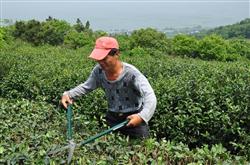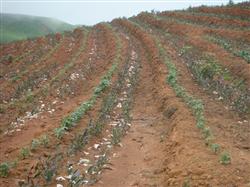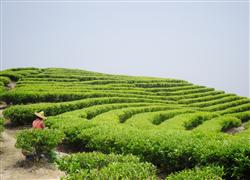Tea planting techniques: how to trim tea trees?

How to trim the tea tree? Please introduce that tea pruning is an artificial measure to restrain the growth advantage of top main branches, which can stimulate buds in lower growing parts to sprout new branches, enhance tree potential, and cultivate high-yield and high-quality crowns. The main pruning methods of tea trees include fixed pruning of young tea trees, light and deep pruning of adult tea trees, re-pruning and table cutting of aged tea trees, and so on. In the period of tea tree pruning, theoretically, the effect is the best before and after the start of spring. However, in order to consider the current economic benefits of spring tea, in addition to young tea tree shape pruning, other pruning should be arranged after the end of spring tea. 1. Shape pruning of young tea seedlings after planting, when the seedling height is more than 30 cm and the main branch is more than 3 mm, it can be trimmed for the first time, leaving a height of about 15 cm after cutting. If the tea seedlings with poor growth do not meet the above standards, the period of setting and pruning should be postponed. After setting and pruning, we should pay attention to keeping the new shoots and strengthen the management of fertilization, and then trim them once a year. The height of each set trim can be increased by about 15 cm on the last cut. After three times of shaping and pruning, the height of the tea tree is 40cm to 50cm, when the skeleton has been formed, and then supplemented by topping and light pruning to further cultivate the crown and picking noodles. For the tool of setting and pruning, the first pruning should be pruned one by one, the distance between the cut and the first axillary bud is 3-5mm, and the lateral bud should be retained as far as possible, so as to grow into a strong backbone branch in the future. When conditions permit, pruning shears should still be used in the second set pruning, which is helpful to improve the quality of pruning. Second, light pruning and deep pruning of adult tea trees. The purpose of light pruning is to promote the germination and growth of tea buds, increase the production density and enhance the growth of tea trees. it is an indispensable technical measure to create and cultivate good picking surface. The degree of light pruning is to cut off 3 to 5 centimeters of branches and leaves on the surface, or you can cut off the autumn shoots of last year, leaving summer shoots. In the form of light pruning of small and medium-sized leaf tea trees, it is appropriate to cut the surface into an arc, which can increase the width of the picking width and is beneficial to increase the yield per unit area. For young and middle-aged tea trees, light pruning can be carried out once a year or every other year, each time by 2cm on the original cut. two。 After years of picking and light pruning, dense and weak branches will be formed on the picking surface of deep-pruned tea trees, which is often called "chicken claw branch". The yield and quality of tea gradually decline. In order to renew the tea picking surface, the deep pruning technique can be adopted to cut off the dense and weak "chicken claw branch" layer, so as to make the tea tree reproduce new branches, improve the germination ability and prolong the life of high and stable yield. Deep pruning should cut off the crown branches, too shallow can not achieve the purpose of updating the picking surface. After deep pruning, the tea trees should still be pruned every year or every other year, leave more new leaves and re-cultivate the picking noodles. Click to get more tea planting techniques click to get more flower planting techniques
- Prev

Tea planting techniques: how to manage the soil in the tea garden?
How to manage the soil in the tea garden? Please introduce the method that the soil management of tea garden is one of the important technical measures to achieve high quality and high yield. Its main purpose is to control weeds, improve soil physical and chemical properties, promote the proliferation of beneficial microorganisms, and create a very favorable underground environment for the good growth and development of tea trees. 1....
- Next

Tea tree planting techniques: how to plant tea trees?
How do tea trees grow? Tea tree planting can refer to the following methods: 1, tea garden planning: tea tree planting, similar to barren hills planting, according to the terrain, slope, slope and other comprehensive planning, do not excavate the table, only dig planting holes, each hole excavation specifications: bottom × high × upper mouth for 40×50×6...
Related
- Fuxing push coffee new agricultural production and marketing class: lack of small-scale processing plants
- Jujube rice field leisure farm deep ploughing Yilan for five years to create a space for organic food and play
- Nongyu Farm-A trial of organic papaya for brave women with advanced technology
- Four points for attention in the prevention and control of diseases and insect pests of edible fungi
- How to add nutrient solution to Edible Fungi
- Is there any good way to control edible fungus mites?
- Open Inoculation Technology of Edible Fungi
- Is there any clever way to use fertilizer for edible fungus in winter?
- What agents are used to kill the pathogens of edible fungi in the mushroom shed?
- Rapid drying of Edible Fungi

